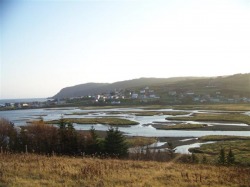Accounting for wellbeing

The field of economics explores how societies distribute and produce goods and services. But it’s not all about interest rates, business cycles and the cost of production.
Economist Doug May studies wellbeing. As a member of the Canadian Research Advisory Group he helped develop the first Canadian Index of Wellbeing. And as director of concept development for the system of Community Accounts (SCA) for the Government of Newfoundland and Labrador, he’s spearheading the best ways to measure what’s important to communities.
The System of Community Accounts provides data for about 400 communities and 220 neighbourhoods in Newfoundland and Labrador. Data is organized within a wellbeing framework that reflects social and economic aspects of people’s lives in their communities and how that contributes to individual and community well-being.
“The accounts have resonated with residents because they provide measurements on factors upon which they have expert knowledge, It is the perfect merge of subject matter knowledge and numbers to describe communities,” said Dr. May adding that the SCA has made data intuitive and meaningful to communities across the province.
The SCA are comprised of two major components: the Production Accounts and the Well-being Accounts. Dr. May explains that, while the two components are linked, the former accounts are “secondary” to the latter since economic activities in terms of production is meant to contribute to the increase in societal well-being.
Rural communities face the unique challenges around sustainability as development in modern economies is determined by industrialization and urbanization. However, cultural tourism is a strategy that has proved popular in providing opportunities to keep workers and businesses from leaving such communities.
Incorporating cultural tourism into the SCA required enlisting a prototype community to gather data.
“Anne St. Croix, a friend of mine who is interested in cultural tourism, introduced me to Michael Mooney who was the Economic Director of Avalon Gateway Economic Zone (18). Michael suggested the community he was from, Branch, as the prototype,” said Dr. May.
Branch’s then-mayor Priscilla Corcoran Mooney was approached and work began on the project with help from Anne St. Croix, Michael Mooney and Kelly Power (who then worked for the town and is the current mayor). The result of the partnership is www.culturalheritageresources.ca, a website composed of photos, videos and personal stories. This site has allowed the community to assume “ownership” of the content and responsibility for it and also provides information for Dr. May to draw upon for SCA.
The true nature of the partnership was revealed to Dr. May by how Branch’s citizens viewed their cultural assets.
“They wanted to record and preserve these assets not only for themselves but also for their children and those former residents who were still alive, but who no longer lived in the community,” he said. Dr. May goes on to explain that this realization has important implications within the Wellbeing Accounts and for conceptual work that is now ongoing in social accounting led by organizations such as the Organization for Economic Co-operation and Development (OECD) and by countries such as Australia, the UK, France and Germany.
Dr. May foresees future benefits for Branch including an increase in cultural tourism and increased well-being to anyone interested in the unique cultural and heritage aspects of the town. He has since expanded on the project with a similar website for the community of Tilting on Fogo Island.